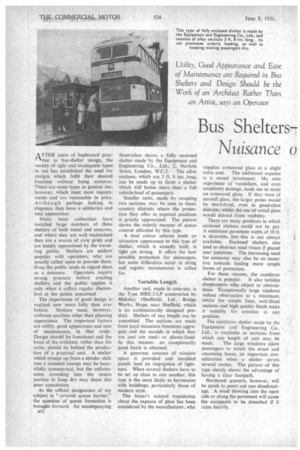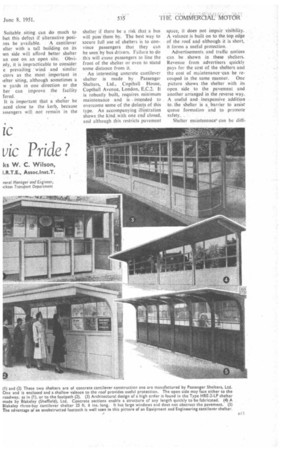Bus Shelters ic Nuisance o uic Pride .
Page 46

Page 47

If you've noticed an error in this article please click here to report it so we can fix it.
ks W. C. Wilson,
I.R.T.E., Assoc.! nst.T.
AFTER years of haphazard practicetice in bus-shelter design, the variety of ugly and inadequate types in use has established the need for designs which fulfil their desired function without being eyesores. There are some types in general use, however, which meet most requirements and are reasonable in price. Alt hough perhaps lacking in elegance, they have a• utilitarian and neat appearance.
Many local authorities have installed large numbers of these shelters of both metal and concrete, and where they are well maintained they are a source of civic pride and are keenly appreciated by the travelling public. Shelters are seldom popular with operators, who are usually called upon to provide them. Even the public tends to regard them
as a nuisance. Operators require strong pressure before erecting shelters and the public applies it only when it suffers regular discomfort at the points concerned.
The importance of good design is realized now more fully than ever before. Shelters must, however, embrace qualities other than pleasing appearance. The important factors are utility, good appearance and ease of maintenance, in that order. Design should be functional and the hand of the architect, rather than the artist, should lie behind the production of a practical unit. A shelter which sweeps up from a slender stalk into a rounded canopy may be beautifully symmetrical, but the unfortunates crowding into the centre portion to keep dry may deem this poor consolation.
As the official designation of my subject is "covered queue barrier," the question of queue formation is brought forward. An accompanying illustration shows a fully enclosed shelter made by the Equipment and Engineering Co., Ltd., 2, Norfolk Street, London, W.C.2. The alloy sections, which are 3 ft. 8 ins, long, can be made up to form a shelter which will hoOse more than a full vehicle-load of passengers.
Smaller units, made by coupling two sections, may be seen in many country -districts where the: protection they offer in exposed positions is greatly appreciated. The picture shows the orderly manner of queue control afforded by this type.
A dual colour scheme lends an attractive appearance to this type of shelter, which is soundly built, is light yet strong. It offers the best possible protection for passengers. but some difficulties occur in siting and regular maintenance is called for.
Variable Length Another unit, made in concrete, is the Type HRE-2-LP constructed by Blakeley (Sheffield), Ltd., Bridge Works, Hope, near Sheffield, which is an architecturally designed product. Shelters of any length can be assembled. The sections are made from hard mountain limestone aggregate and the moulds in which they are cast are steelor plastic-lined. In this manner, an exceptionally good finish is obtained.
A generous amount of window space is provided and moulded panels lend an impression of lightness. When several shelters have to be set sin close to one another, this type is the most likely to harmonize with buildings, particularly those of modern style.
The buyer's natural trepidation about the expanse of glass has been considered by the manufacturer, who supplies armoured glass at a slight extra cost. The additional expense is a sound investment. My own experience of vandalism, and even accidental damage, leads me to insist on armoured glass. If they were of normal glass, the larger panes would be short-lived, even in good-class districts, whilstthe use of wired glass would detract from visibility.
There are many positions in which enclosed shelters could not be put. A minimum pavement width of 10 ft. is desirable, but this is not always available. Enclosed shelters also tend to obstruct road vision if placed near junctions. The increasing need for economy may also be an incentive towards finding more simple forms of protection. • For these reasons, the cantilever
shelter is popular. It also satisfies shopkeepers who object to obstructions. -Exceptionally large windows reduce obstruction to a minimum, whilst the simple lines, well-fitted sections and high quality finish make it suitable for erection in any position.
The cantilever shelter made by the Equipment and Engineering Co., Ltd., is available in sections from which any length of unit may be made. The large windows allow passengers to watch the street and oncoming buses, an important consideration when a shelter serves several routes. The picture of this type clearly shows the advantage of having a clear footpath.
Hardened queuers, however, will be quick to point out one disadvantage. A wind blowing into the open side or along the pavement will cause the occupants to be drenched if it rains heavily.




















































































